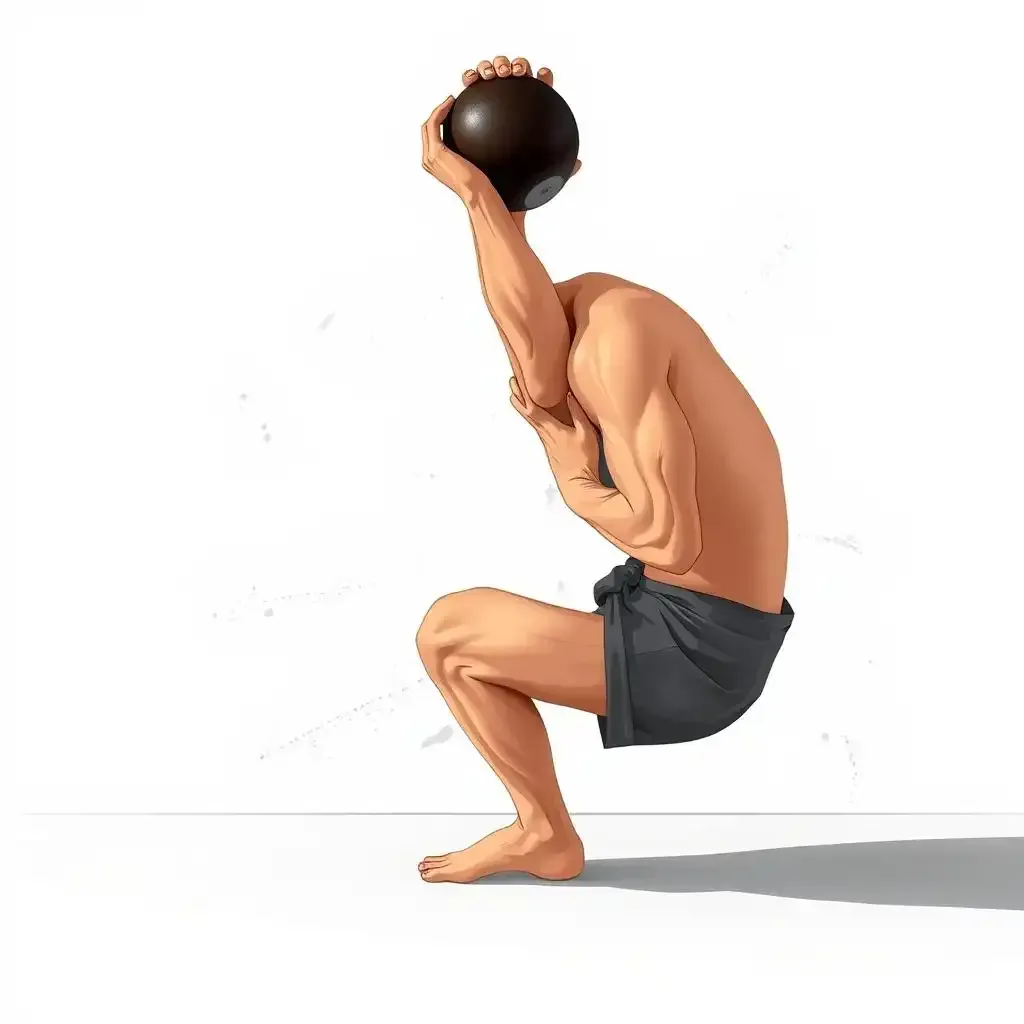Table of Contents
Are your joints stiff and creaky? Do you dream of moving with the grace of a ninja, but your body feels more like a rusty robot? Then get ready to ditch the aches and pains and find the amazing world of kettlebells for joint mobility! Kettlebells aren't just for muscle-heads; they're a fantastic tool for improving flexibility and range of motion. This article, brought to you by kettlebellworkout.homes, will guide you through safe and effective exercises, helping you access smoother, more pain-free movement. We'll explore how kettlebells can target specific joints, improve your overall body awareness, and ultimately help you move better, feel better, and live better. Whether you're a seasoned athlete or just starting your fitness progression, this guide will equip you with the knowledge and practical exercises to incorporate kettlebells into your routine for optimal joint health. Remember, always consult your doctor before starting any new workout regime. Let's get started!
Kettlebells and Joint Mobility: A Beginner's Guide
Why Kettlebells for Joint Mobility?
Imagine your joints as hinges on a door. If you don’t use them, they get rusty, right? Kettlebells are like the WD-40 for your body’s hinges. They help keep your joints lubricated and moving smoothly. When you lift a kettlebell, you're not just working your muscles; you're also engaging your joints in a way that keeps them healthy and pain-free.
One of the best things about kettlebells is that they can be used for a wide range of exercises. Whether you're doing swings, squats, or presses, each movement targets different joints and muscles. This makes kettlebells a versatile tool for improving joint mobility. If you’re new to kettlebells, check out our to get a feel for the basics.
Exercise | Target Joints | Benefits |
|---|---|---|
Kettlebell Swings | Hips, Knees | Enhances hip flexibility and knee stability |
Goblet Squats | Knees, Ankles | Improves knee and ankle mobility |
Overhead Press | Shoulders, Elbows | Strengthens shoulder and elbow joints |
Getting Started with Kettlebell Exercises for Joint Mobility
Before you start swinging that kettlebell, it's crucial to warm up properly. Think of your warm-up as a pre-flight check. You wouldn’t take off in a plane without making sure everything is in order, right? The same goes for your body. A good warm-up can include dynamic stretches like leg swings, arm circles, and hip openers. These movements help increase blood flow and get your joints ready for action.
When you’re ready to start your kettlebell routine, focus on exercises that promote full-range movements. For example, the kettlebell step-down is a great exercise for knee and ankle mobility. It involves stepping down from a raised surface with a kettlebell in one hand, which helps strengthen the stabilizing muscles around your knees and ankles. If you need more detailed instructions, our can help.
- Start with lighter kettlebells to avoid strain
- Focus on form and control, not just weight
- Gradually increase the weight as you get more comfortable
Unlocking Joint Flexibility with Kettlebells: Exercises and Safety

Unlocking Joint Flexibility With Kettlebells Exercises And Safety
Why Safety Matters in Kettlebell Exercises for Joint Mobility
Just like any other form of exercise, it's essential to prioritize safety when it comes to using kettlebells for joint mobility. If you don't use proper form and technique, you can put unnecessary strain on your joints, leading to injury or exacerbating existing conditions. Remember, the goal is to make your joints feel better, not worse!
Before you start your kettlebell routine, make sure you've warmed up properly. You can do some light cardio, like jumping jacks or jogging in place, or try some dynamic stretches like leg swings and arm circles. This will help increase blood flow and get your joints ready for movement. For more information on kettlebell warm-up exercises, check out our article.
Choosing the Right Kettlebell Exercises for Joint Mobility
When it comes to kettlebells, not all exercises are created equal. Some are better suited for joint mobility than others. For example, the kettlebell swing is a great exercise for hip and knee mobility, while the kettlebell press is more geared towards shoulder mobility. Remember to start with lighter weights and focus on proper form and technique. You can always increase the weight as you get more comfortable. Consider beginner kettlebell exercises for joint mobility
Exercise | Target Joints | Benefits |
|---|---|---|
Kettlebell Swing | Hips, Knees | Enhances hip and knee flexibility |
Kettlebell Press | Shoulders, Elbows | Strengthens shoulder and elbow joints |
Kettlebell Snatch | Shoulders, Wrists | Improves shoulder and wrist mobility |
- Focus on proper form and technique
- Start with lighter weights and progress gradually
- Listen to your body and rest when needed
Kettlebell Workouts for Improved Joint Range of Motion

Kettlebell Workouts For Improved Joint Range Of Motion
One of the coolest things about kettlebells is how they can help you improve your joint range of motion. Think of your joints like hinges on a door. If you don’t use them, they get rusty. Kettlebells are like the WD-40 for your hinges. They keep your joints lubricated and moving smoothly.
But it's not just about swinging the kettlebell wildly. It's about doing specific exercises that target different joints and muscles. For example, the kettlebell windmill is fantastic for shoulder and hip mobility. As you lock the kettlebell overhead and hinge at the hips, you’re opening up your shoulders and engaging your core, all while keeping your lower back stable.
Exercise | Target Joints | Benefits |
|---|---|---|
Kettlebell Windmill | Shoulders, Hips | Improves shoulder and hip flexibility |
Kettlebell Halos | Shoulders, Wrists | Enhances shoulder and wrist mobility |
Kettlebell Turkish Get-Up | Shoulders, Hips, Ankles | Strengthens and mobilizes multiple joints |
Another great exercise is the kettlebell halo. This move involves circling the kettlebell around your head, which really opens up your shoulders and wrists. It’s like giving your joints a little dance party. Not only does it feel good, but it also helps prevent stiffness and improves your overall joint health.
And let’s not forget the kettlebell Jefferson Curl. This one is a bit more advanced, but it’s amazing for spinal mobility. You start by standing upright with the kettlebell in both hands, then slowly hinge forward while keeping your spine neutral. It’s like a gentle stretch that helps you maintain the natural curve of your spine.
- Start with lighter kettlebells to avoid strain
- Focus on form and control, not just weight
- Gradually increase the weight as you get more comfortable
Remember, the key to improving joint range of motion is consistency. Don’t just do these exercises once and expect miracles. Make it a regular part of your routine, and over time, you’ll notice a big difference in how your joints feel and function. If you’re new to kettlebells, check out our to get a feel for the basics.
So, grab a kettlebell and get moving! Your joints will thank you for it. And if you need more detailed instructions, our can help you get started on the right foot.
Advanced Kettlebell Techniques for Enhanced Joint Mobility

Advanced Kettlebell Techniques For Enhanced Joint Mobility
Mastering the Kettlebell Turkish Get-Up
Hey there, fellow kettlebell enthusiast! Let's talk about the Turkish Get-Up (TGU). This isn't your grandma's exercise; it's a full-body movement that's amazing for joint mobility. Think of it like a sophisticated dance with your kettlebell – a controlled, flowing sequence that works wonders for your shoulders, hips, and core. It's all about precision and control. You start lying on your back, press the kettlebell overhead, and then gracefully transition to a standing position, all while maintaining perfect form. It's a real challenge, but once you master it, you'll feel like a total badass. I remember my first TGU – it was humbling, to say the least! I felt like a newborn giraffe learning to walk. But with practice, I found my balance and strength, and now it's one of my favorite exercises. If you’re struggling with the TGU, check out our guide to first to build a solid foundation.
The TGU is a fantastic way to improve your overall body awareness. You'll learn to engage your core muscles, stabilize your joints, and control your movements with precision. It's not just about strength; it's about coordination and balance. Plus, it's a great way to improve your posture. I’ve noticed that since incorporating TGUs into my routine, my back feels much stronger and more flexible. And, let’s be honest, it’s pretty impressive to watch someone flawlessly execute a TGU. It’s like watching a graceful ballet dancer, only with more kettlebells. If you're ready for a more intense challenge, check out our section.
Phase | Joint Focus | Key Considerations |
|---|---|---|
Lie Down to Sit Up | Shoulders, Hips | Maintain a stable core |
Sit Up to Kneel | Hips, Knees | Controlled movement, smooth transition |
Kneel to Stand | Ankles, Knees | Maintain balance, controlled rise |
Exploring the Kettlebell Windmill
Next up is the kettlebell windmill. This exercise is all about rotational mobility. Think of your body as a well-oiled machine – each joint working in harmony. The windmill challenges your shoulder, hip, and spine mobility. You'll stand with your feet apart, holding a kettlebell in one hand, and then slowly rotate your torso while maintaining a straight spine. It's a bit tricky at first, but once you get the hang of it, you'll feel a fantastic stretch throughout your entire body. It's particularly helpful for improving spinal mobility, which is super important for preventing back pain. It's a bit like untangling a knot in your spine, which sounds more painful than it actually is!
I find the windmill to be incredibly beneficial for improving my overall athleticism. The rotational movement involved improves my capability and coordination. Remember to focus on controlled movement and deep breathing. Don't rush it! Take your time and let your body guide you. This is where you’ll really feel that association between your mind and your body. It's a meditative kind of exercise, a dance with your kettlebell. It’s a fantastic way to improve your mobility and flexibility, and it’s a great way to challenge yourself. For more kettlebell exercises customized to your fitness level, check out our page.
- Start with a lighter kettlebell
- Focus on controlled movements
- Breathe deeply throughout the exercise
Final Thought
Improving joint mobility with kettlebells is a trip, not a race. Consistency is key. Start slowly, listen to your body, and celebrate your progress. Remember, the goal isn't to become a kettlebell-swinging superhero overnight, but to cultivate a healthier, more mobile body. With dedication and the right approach, you can access a new level of freedom and ease in your movement. So grab your kettlebell, and let's get moving!